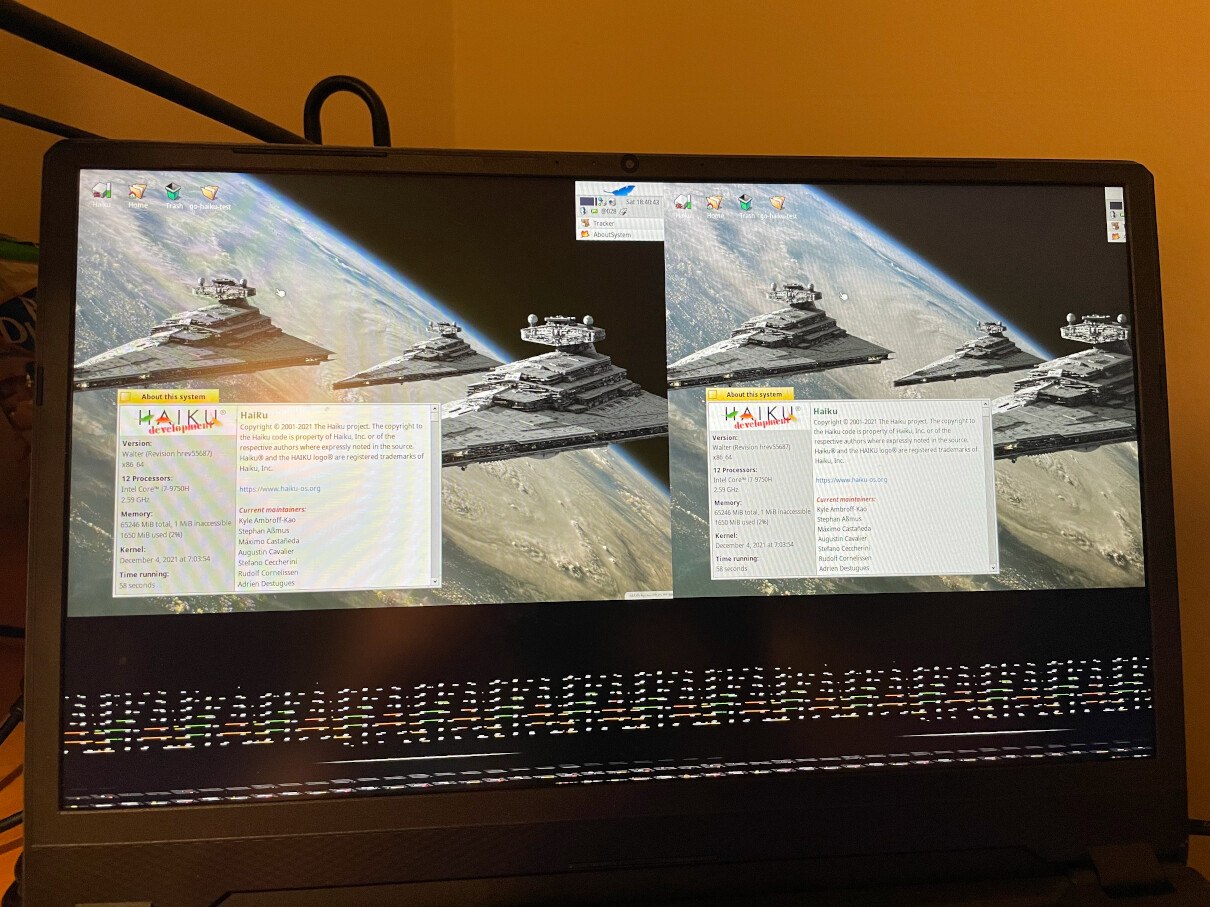Hi kim1963, If all is right the slider for background intensity should be gone now since hrev55685.
This slider is only meant for laptops.
i have upload the syslog in the ticket 
and yes, no display is detected (only make the booticons resolution work at most)
thx for your work!
I submitted a ticket #17451, where the driver shows double, and part of the icon boot screen at the bottom. The machine has both Intel graphics (CoffeeLake i7-9750H) and Nvida RTX. Selecting integrated graphics from the Linux-side control panel for the bios, which disables the Nvidia card, didn’t help. This is hrev55687.

Noticed that my laptop is now working with the Intel driver now! Thanks!
It does let me select a larger resolution than is supported by the laptop screen. It just draws the rest of the desktop off screen. Is that a known issue already?
how is it an issue?
Did you try to set the native resolution in the Screen Preferences?
Windows will open in wrong positions if they use something like middle of the screen, it’s hard to figure out also as a user what the real native resolution is.
What should be the behavior of the graphics driver in this case?
This is known issue. Was on Skylake too, but is fixed now!
I can chose a bigger res than nativ, and will get lower DPI to fit.
Very nice.
Haiku shoul chose the nativ res at boot if possible. Like VESA did
The driver relies on EDID infos to know available resolutions, right? Could it be that, in some cases, screens are reporting infos that are misleading?
For example, my screen is 1680x1050. Maybe it is only a typo somewhere but, this is what I can read in syslog:
KERN: Supported Future Video Modes:
KERN: 1680x1680@60Hz (id=179)
@rudolfc another patch to review: https://review.haiku-os.org/c/haiku/+/4760 thanks!
Yes, it happened for me on a TV with HDMI input. It was a 720p TV, they attempted to report support for 1080i, but messed it up and as a result the default resolution was a very distorted 1920x540.
The only way to workaround this would be to have a list of “quirks”: a database of broken edid reports, identified by the display model number, and a copy of the correct EDID information to inject.
Since the fix is not so difficult (go to screen preferences and select the correct resolution), it may not be worth the effort to collect and maintain such a database of badly programmed hardware.
Hi, the 1680x1680 I see on a lot of displays. I find that strange too, but if it’s an error, it’s a systematic one (or the id 179 is defined wrong in our common code…)
Hi,
On my old SandyBridge laptop (gen6), At the moment of displaying the desktop (once all the boot icons have been successfully displayed/lit-up), the built-in flat panel displays roughly the desktop image over random coloured dots, and then the screen gradually turns white within 1 or 2 seconds.
syslog and gpu registers here : #17350
(quite similar to #15746)
Thanks for reporting, for both tickets I’ll retry setting up the DP links. See https://dev.haiku-os.org/ticket/17350 for an explanation of the situation. I’ll get back to you on this 
@rudolfc, do you have an idea what registers in Radeon GPU are relevant to dump for fixing modesetting? HDMI output works with UEFI GOP framebuffer, but not with radeon_hd.accelerant (only VGA works).
No, unfortunately not, I never looked at this brand before though at one time I did register for register level doc access back in the ATI days. But since you say it works with GOP framebuffer, and if I assume the programming done would stay intact when you leave the UEFI boot services, I’d say, just comment out all stuff in the radeon driver until you keep having your screen, and then slowly re-enable code until you reach the point where the right (wrong  ) registers get hit.
) registers get hit.
This kind of working at it is something I do for some 20 years now… Not always nice to do, but it gets you in the right direction in the end. Still, someone else might have more direct hints. But in order to get an understanding oneself it’s always good to fiddle with the driver as I described, and ‘compare notes’ with the register level docs to get an insight in that: which in turn will help you to get you where want to be.
At least, for me this is how it works… 
BTW @x512 (off topic maybe): so Vulkan on Linux works from Ivybridge onwards, and there are even some notes that it might work on Sandy bridge as oldest Intel chipset. Once all your work makes it into the tree and we have the infrastructure in place, I think I’d like to have a look at it all and see what it would take to get Intel support going as well… No idea if that would be feasible at this time, but can’t hurt looking at it I think 
A least you need ring buffer and memory manager working. The core of acceleration is submitting command buffers to 3D engine ring buffer.
Intel Vulkan driver in Mesa it more dirty then Radeon and it need some adjustments to be operational in Haiku.